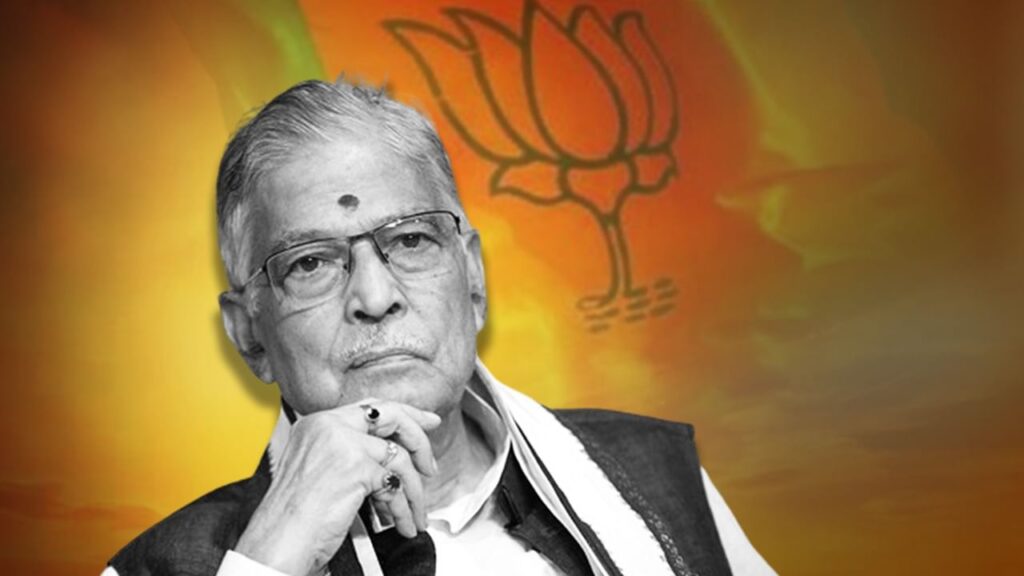In 1990, as the Bharatiya Janata Party (BJP) was rising to prominence and the dominance of leaders like Atal Bihari Vajpayee and Lal Krishna Advani was established, a new leader emerged within the party—Murli Manohar Joshi. Unlike his counterparts, Joshi lacked extensive organizational experience.
A former science professor, Murli Manohar Joshi became the President of the BJP in 1991, serving until 1993. Within political circles, he was often referred to as part of the “Tridev” alongside Vajpayee and Advani, representing the powerful trio within the party.
In this special series on BJP Presidents, read about the journey of Murli Manohar Joshi, the party’s third president…
How Did Murli Manohar Joshi Become President?
The year was 1991. Despite numerous attempts by President Lal Krishna Advani, the BJP failed to secure a substantial presence in the central government, winning only 120 seats in the Lok Sabha elections. Meanwhile, Congress was nearing a majority on its own.
After the elections, Advani was appointed as the Leader of the Opposition in the Lok Sabha, prompting the party’s search for a new president. After three months, Joshi was entrusted with the leadership of the BJP, thus serving as its third president from 1991 to 1993.
Why Was Joshi Chosen for the Presidency?
It was the third time in the 11-year-old party’s history that leadership was handed to a leader from the upper caste. The previous presidents were Atal Bihari Vajpayee (Brahmin) and Lal Krishna Advani (Kayasth). Joshi also hailed from the Brahmin community.
However, Joshi’s appointment was not without controversy; leaders like Govindacharya and Kalyan Singh expressed their concerns quietly within the party. Still, three main reasons contributed to Joshi’s ascendancy:
- 1. Joshi was a friend of the then Sangh General Secretary, Rajendra Singh, also known as Raju Bhaiya. It is said that Raju Bhaiya played a significant role in Joshi’s appointment. Raju Bhaiya would later become the head of the RSS.
- 2. After the 1991 electoral setback, the BJP sought to refresh its leadership. Joshi, being ten years younger than Vajpayee and seven years younger than Advani, represented a new generation. Upon his appointment, Joshi included young leaders like Arun Jaitley in his team.
- 3. The Mandal movement emerged in 1990, prompting the BJP to launch its response through the “Kamal Mandal” policy. Joshi was a strong proponent of the Swadeshi movement and was expected to lead this charge.
A Journey to Kashmir and Hoisting the National Flag
After assuming the presidency, Murli Manohar Joshi began to emphasize nationalism within the BJP’s Hindutva strategy. He announced a unity tour from Kashmir to Kanyakumari, with Narendra Modi tasked with managing this initiative.
This journey was significant for two reasons: first, at that time, Kashmiri Pandits were being forcibly expelled from the valley, and second, incidents of terrorism were escalating in the region. During this tour, Joshi declared his intent to hoist the national flag at the controversial Lal Chowk in Kashmir, raising security concerns among the armed forces.
Reportedly, the army was hesitant to either prevent Joshi from going to Lal Chowk, which could embolden terrorists, or to support him fully. Ultimately, on January 26, 1992, with significant security in place, Joshi successfully hoisted the flag, fulfilling his promise.
Secret Meetings Led to the Demolition of Babri Masjid
In December 1992, the issue surrounding the Babri Masjid in Ayodhya gained momentum. Thousands of workers from the Vishwa Hindu Parishad had camped in Ayodhya. During this tumultuous time, Murli Manohar Joshi also announced his planned visit to Ayodhya, causing expectations that he might resolve the situation.
On the evening of December 5, Joshi held a meeting with Advani at Vinay Katiyar’s residence. The CBI’s subsequent chargesheet alleged this meeting was where plans for the Babri demolition were formed. Following this assembly, Joshi quickly moved from Ayodhya back to Delhi.
Despite being accused of conspiracy in the Babri demolition case, Joshi vehemently denied any wrongdoing, claiming that he was deliberately framed. In 2020, the court acquitted him due to a lack of evidence.
Avoiding the Stage with Bal Thackeray
At the time Joshi became BJP president, the party was in alliance with the Shiv Sena in Maharashtra. Notably, however, Joshi never shared a platform with Bal Thackeray, the leader of the Shiv Sena and a staunch Hindutva advocate.
When asked about this decision in an interview, Joshi stated, “I disagree with Bal Thackeray on several counts, particularly regarding his controversial statements about Gandhi. In my view, Gandhi is a revered figure in our nation.”
Power Struggles and Loss of the Presidency
In 1993, amidst upcoming assembly elections in Uttar Pradesh and Delhi, a power struggle emerged between the factions led by Joshi and Advani. A report in India Today highlighted this tension, depicting Advani’s camp making continuous attempts to undermine Joshi.
Ultimately, just before the elections, leadership was returned to Advani. In the assembly elections that followed, the BJP fell short of forming a government in Uttar Pradesh, while it did manage to secure victory in Delhi under Advani’s leadership.
Close Calls for the Presidency
In 2005, after the Jinnah controversy emerged, Advani resigned, and many expected Joshi to step in. However, Rajnath Singh emerged as the favorite due to age considerations, sidelining Joshi from the race.
At 90 years old, Joshi served as a Member of Parliament until 2019. Currently, he is relatively inactive in politics and is focusing on recovering his health.

